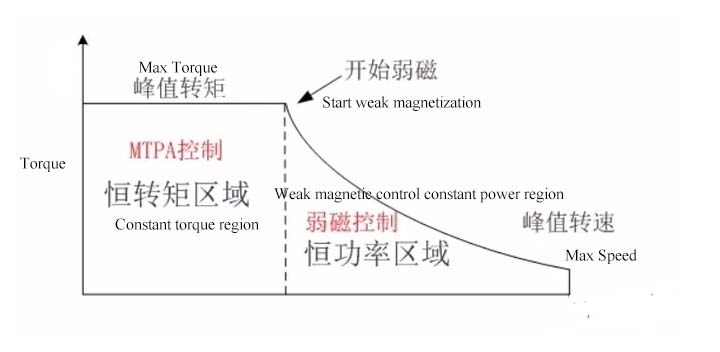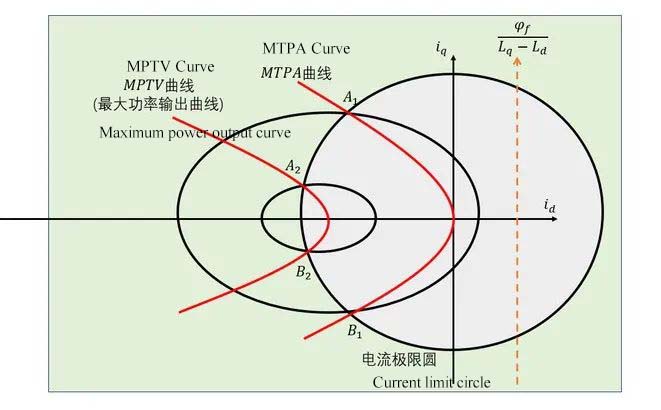01. MTPA and MTPV
Permanent magnet synchronous motor is the core driving device of new energy vehicle power plants in China. It is well known that at low speeds, permanent magnet synchronous motor adopts maximum torque current ratio control, which means that given a torque, the minimum synthesized current is used to achieve it, thereby minimizing copper loss.
So at high speeds, we cannot use MTPA curves for control, we need to use MTPV, which is the maximum torque voltage ratio, for control. That is to say, at a certain speed, make the motor output the maximum torque. According to the concept of actual control, given a torque, the maximum speed can be achieved by adjusting iq and id. So where is the voltage reflected? Because this is the maximum speed, the voltage limit circle is fixed. Only by finding the maximum power point on this limit circle can the maximum torque point be found, which is different from MTPA.
02. Driving conditions
Usually, at the turning point velocity (also known as the base velocity), the magnetic field begins to weaken, which is point A1 in the following figure. Therefore, at this point, the reverse electromotive force will be relatively large. If the magnetic field is not weak at this time, assuming that the pushcart is forced to increase the speed, it will force iq to be negative, unable to output forward torque, and forced to enter the power generation condition. Of course, this point cannot be found on this graph, because the ellipse is shrinking and cannot stay at point A1. We can only reduce iq along the ellipse, increase id, and get closer to point A2.
03. Power generation conditions
Why does power generation also require weak magnetism? Shouldn't strong magnetism be used to generate relatively large iq when generating electricity at high speeds? This is not possible because at high speeds, if there is no weak magnetic field, the reverse electromotive force, transformer electromotive force, and impedance electromotive force may be very large, far exceeding the power supply voltage, resulting in terrible consequences. This situation is SPO uncontrolled rectification power generation! Therefore, under high-speed power generation, weak magnetization must also be carried out, so that the generated inverter voltage is controllable.
We can analyze it. Assuming that braking starts at the high-speed operating point B2, which is feedback braking, and the speed decreases, there is no need for weak magnetism. Finally, at point B1, iq and id can remain constant. However, as the speed decreases, the negative iq generated by the reverse electromotive force will become less and less sufficient. At this point, power compensation is needed to enter energy consumption braking.
04. Conclusion
At the beginning of learning electric motors, it is easy to be surrounded by two situations: driving and generating electricity. In fact, we should first engrave the MTPA and MTPV circles in our brain, and recognize that the iq and id at this time are absolute, obtained by considering the reverse electromotive force.
So, as for whether iq and id are mostly generated by the power source or by the reverse electromotive force, it depends on the inverter to achieve regulation. iq and id also have limitations, and regulation cannot exceed two circles. If the current limit circle is exceeded, the IGBT will be damaged; If the voltage limit circle is exceeded, the power supply will be damaged.
In the process of adjustment, the target's iq and id, as well as the actual iq and id, are crucial. Therefore, calibration methods are used in engineering to calibrate the appropriate allocation ratio of iq's id at different speeds and target torques, in order to achieve the best efficiency. It can be seen that after circling around, the final decision still depends on the engineering calibration.
Post time: Dec-11-2023






